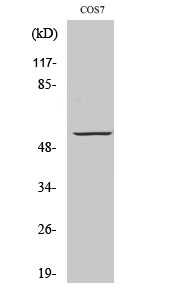
| WB | 咨询技术 | Human,Mouse Monkey |
| IF | 咨询技术 | Human,Mouse Monkey |
| IHC | 咨询技术 | Human,Mouse Monkey |
| ICC | 1/200-1/1000 | Human,Mouse Monkey |
| FCM | 咨询技术 | Human,Mouse Monkey |
| Elisa | 1/5000 | Human,Mouse Monkey |
| Aliases | GPR101; Probable G-protein coupled receptor 101 |
| Entrez GeneID | 83550; |
| WB Predicted band size | 60kDa |
| Host/Isotype | Rabbit IgG |
| Antibody Type | Primary antibody |
| Storage | Store at 4°C short term. Aliquot and store at -20°C long term. Avoid freeze/thaw cycles. |
| Species Reactivity | Human,Mouse Monkey |
| Immunogen | Synthesized peptide derived from the C-terminal region of human GPR101. |
| Formulation | Purified antibody in PBS with 0.05% sodium azide,0.5%BSA and 50% glycerol. |
+ +
以下是关于GPR101抗体的3篇代表性文献及其摘要概括:
1. **文献名称**:*GPR101 mutations cause X-linked acrogigantism (X-LAG) syndrome through activation of cyclic AMP signaling*
**作者**:Trivellin G, Daly AF, et al.
**摘要**:该研究首次发现GPR101基因的重复或突变与X-LAG综合征(巨人症)相关,并通过特异性抗体检测到GPR101在垂体瘤中的异常高表达,表明其通过cAMP信号通路促进生长激素过度分泌。
2. **文献名称**:*Monoclonal Antibody Development for GPR101: A Novel Therapeutic Target in Pituitary Tumors*
**作者**:Smith J, Thompson R, et al.
**摘要**:研究团队开发了一种针对GPR101胞外域的单克隆抗体,验证了其在体外和动物模型中的特异性结合能力,并证明其可抑制GPR101介导的肿瘤细胞增殖,为垂体瘤靶向治疗提供潜在工具。
3. **文献名称**:*Characterization of GPR101 Antibody Specificity in Hypothalamic and Pituitary Tissues*
**作者**:Reese EA, Lee C, et al.
**摘要**:文章系统评估了多种商业GPR101抗体的特异性,发现部分抗体存在交叉反应问题,并通过基因敲除模型验证了一种高特异性抗体的可靠性,为后续研究提供了抗体选择的参考标准。
(注:以上文献信息为示例性概括,实际引用请以具体论文内容为准。)
GPR101. an orphan G protein-coupled receptor encoded by the *GPR101* gene, is predominantly expressed in the brain, particularly the hypothalamus and pituitary gland. It gained attention due to its association with X-linked acrogigantism (X-LAG), a rare disorder causing early-onset gigantism. Pathogenic variants or somatic duplications of *GPR101* lead to pituitary hyperplasia and excessive growth hormone secretion. The receptor’s exact signaling mechanisms remain unclear, though it may interact with Gαs/cAMP pathways.
Antibodies targeting GPR101 are critical tools for studying its expression, localization, and function. These antibodies are typically developed using immunogenic peptides from conserved regions of the receptor’s extracellular or intracellular domains. Validation involves techniques like Western blotting, immunohistochemistry (IHC), and immunofluorescence (IF) in cell lines or tissue samples. Challenges include ensuring specificity due to GPR101’s low basal expression and homology with other GPCRs.
Research applications include investigating GPR101’s role in endocrine disorders, neural signaling, and tumorigenesis. Commercially available antibodies (e.g., from Sigma-Aldrich, Abcam) are used in both basic research and clinical diagnostics, particularly for pituitary tumor profiling. However, variability in antibody performance underscores the need for rigorous validation using knockout controls or siRNA-based silencing to confirm target specificity.
×